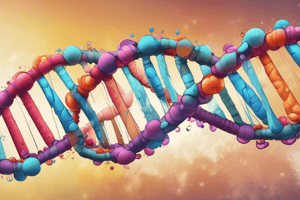Podcast
Questions and Answers
What is the first step in the four-step process for DNA replication enzymes?
What is the first step in the four-step process for DNA replication enzymes?
- Migrate
- Replicate
- Unwind
- Relax (correct)
Which of the following are ways for drugs to block bacterial DNA replication? (Select all that apply)
Which of the following are ways for drugs to block bacterial DNA replication? (Select all that apply)
- Inhibit the synthesis of nucleotides (correct)
- Bind to enzymes of DNA replication (correct)
- Prevent DNA transcription
- Bind to bacterial DNA (correct)
Fluoroquinolones act on what two enzymes of bacterial DNA replication?
Fluoroquinolones act on what two enzymes of bacterial DNA replication?
DNA gyrase and topoisomerase IV
What are fluoroquinolones?
What are fluoroquinolones?
What infections are fluoroquinolones clinically used to treat? (Select all that apply)
What infections are fluoroquinolones clinically used to treat? (Select all that apply)
Moxifloxacin (Alelox) is effective against?
Moxifloxacin (Alelox) is effective against?
Ciprofloxacin (Cipro) is the drug of choice for which conditions?
Ciprofloxacin (Cipro) is the drug of choice for which conditions?
Fluoroquinolones exhibit postantibacterial effects.
Fluoroquinolones exhibit postantibacterial effects.
What are some adverse side effects related to fluoroquinolones' cartilage toxicity?
What are some adverse side effects related to fluoroquinolones' cartilage toxicity?
Which gastrointestinal adverse effects are associated with fluoroquinolones? (Select all that apply)
Which gastrointestinal adverse effects are associated with fluoroquinolones? (Select all that apply)
Fluoroquinolones have a risk for serious hypersensitivity reactions.
Fluoroquinolones have a risk for serious hypersensitivity reactions.
What cardiac adverse effect can fluoroquinolones cause?
What cardiac adverse effect can fluoroquinolones cause?
What are nervous system toxicity side effects associated with fluoroquinolones? (Select all that apply)
What are nervous system toxicity side effects associated with fluoroquinolones? (Select all that apply)
What liver toxicity is associated with fluoroquinolones?
What liver toxicity is associated with fluoroquinolones?
What is the phototoxicity risk for fluoroquinolone patients?
What is the phototoxicity risk for fluoroquinolone patients?
What types of resistance can develop against fluoroquinolones? (Select all that apply)
What types of resistance can develop against fluoroquinolones? (Select all that apply)
Match the following fluoroquinolone generations to their specifics:
Match the following fluoroquinolone generations to their specifics:
Flashcards are hidden until you start studying
Study Notes
DNA Replication Process
- Four steps involved: relax, unwind, replicate, and migrate.
- Relaxation of supercoil by DNA gyrase.
- DNA helicase unwinds the DNA strands post-relaxation.
- DNA polymerase adds precursor bases to form new DNA strands.
- Topoisomerase IV frees interlocked strands to allow migration and segregation into daughter cells.
Mechanisms of Action Against Bacterial DNA Replication
- Drugs can inhibit synthesis or availability of nucleotides.
- Some bind directly to bacterial DNA, disrupting uncoiling processes.
- Others target enzymes involved in DNA replication, stopping new DNA formation.
Fluoroquinolones
- Primarily target enzymes DNA gyrase and topoisomerase IV.
- Known for their bactericidal properties and inhibiting bacterial DNA synthesis.
- Classified into four generations with varying scopes of activity.
Clinical Applications of Fluoroquinolones
- Effective for treating infections in respiratory, gastrointestinal, genitourinary tracts, and skin/soft tissue.
Specific Fluoroquinolones
- Moxifloxacin (Alelox) is effective against anaerobic bacteria.
- Ciprofloxacin (Cipro) is preferred for Pseudomonas aeruginosa and postexposure prophylaxis for anthrax and other bioterrorism-related infections.
Postantibacterial Effects
- Bactericidal effects can persist post-administration, continuing after serum levels drop below minimum inhibitory concentrations.
Adverse Effects of Fluoroquinolones: Cartilage Toxicity
- Potential tendon toxicity in children due to cartilage matrix effects.
- Increased risk of tendinitis and tendon ruptures in patients over 65.
Adverse Effects of Fluoroquinolones: GI Toxicity
- Common side effects include nausea, diarrhea, and vomiting.
- Absorption can be delayed by multivitamins/minerals containing calcium, zinc, iron, aluminum, or magnesium.
- Associated with risk of Clostridium difficile-associated diarrhea (CDAD).
Adverse Effects of Fluoroquinolones: Hypersensitivity Reactions
- Risk of serious and potentially fatal reactions after multiple doses, necessitating an FDA warning.
Adverse Effects of Fluoroquinolones: Cardiotoxicity
- Moxifloxacin linked to dysrhythmias and prolonged QT interval.
Adverse Effects of Fluoroquinolones: Nervous System Toxicity
- Symptoms include dizziness, headache, sleep disturbances, seizures, and potential peripheral neuropathy.
Adverse Effects of Fluoroquinolones: Hepatotoxicity
- May elevate hepatic enzyme levels, suggesting potential liver toxicity.
Adverse Effects of Fluoroquinolones: Phototoxicity
- Patients can exhibit moderate to severe reactions when exposed to sunlight.
Fluoroquinolones Resistance Mechanisms
- DNA gyrase alteration can reduce fluoroquinolone binding.
- Some bacteria develop efflux pumps to remove these drugs.
- Changes to the cell wall can decrease permeability to fluoroquinolones.
Fluoroquinolones: First Generation
- Example: Nalidixic acid (NegGram).
- Administered orally; effective against Enterobacteriaceae.
- Used primarily for uncomplicated urinary tract infections.
Fluoroquinolones: Second Generation
- Common examples include ciprofloxacin (Cipro), norfloxacin (Noroxin), and ofloxacin (Floxin).
- Administered either orally or intravenously and active against Enterobacteriaceae and atypical pathogens.
- Indicated for complicated UTIs, gastroenteritis with severe diarrhea, and STIs.
Studying That Suits You
Use AI to generate personalized quizzes and flashcards to suit your learning preferences.




